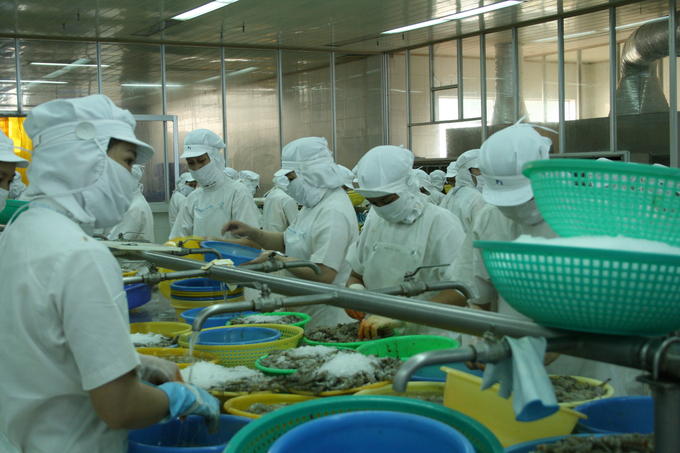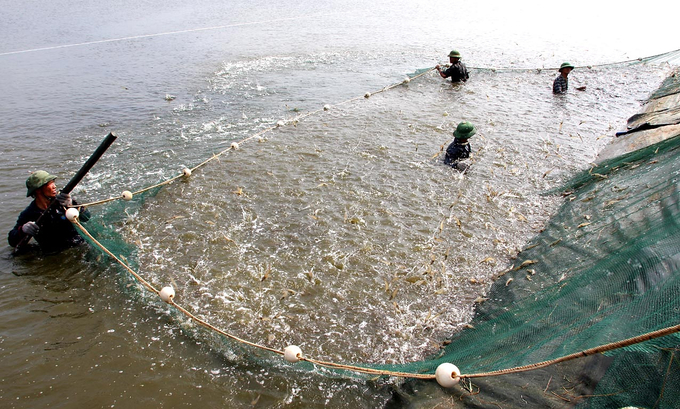November 28, 2025 | 01:00 GMT +7
November 28, 2025 | 01:00 GMT +7
Hotline: 0913.378.918
November 28, 2025 | 01:00 GMT +7
Hotline: 0913.378.918

According to the Ministry of Agriculture and Rural Development (MARD), Vietnam’s fisheries export value in the first six months of 2023 is estimated at VND 4.13 billion, down 27.4% compared to the same period in 2022. Photo: Hong Tham.
Vietnam’s fisheries industry implements its production and development plan for 2023 in a mix of advantages and challenges, in which the export market is struggling the most.
Fisheries output in the first six months of the year is approximately 4.27 million tons, reaching 47.2% of the plan, and aquaculture in particular achieves more than 2.336 million tons. Fisheries export value is estimated at USD 4.13 billion, down 27.4% over the same period in 2022. Brackish water shrimp reaches USD 1.56 billion, down 36.6% over the same period, pangasius reaches USD 885.5 million, down 38%.
Fisheries exports in May and June show much better results than the first months, signaling that the export market is starting to improve and is likely to recover in the third and fourth quarters of the year. Yet current product prices remain low and profits are not much, so farmers have this mindset of "anchoring the ponds" and waiting for signals from the market, which reveals certain risks. In the last months of 2023, the industry may lack inputs to serve processing and export, thus affecting the growth target.
In order to secure stable development for aquaculture in the last months of 2023, thus meeting the demand for aquatic inputs in terms of both quantity and quality, the Ministry of Agriculture and Rural Development requests the People's Committees of provinces and cities under Central to urgently organize and implement a number of key tasks:
1. Organize forces to grasp, review, synthesize and compile statistics on the input sources, quantity and production capacity in service of aquaculture; the amount of aquatic products currently raised; the amount of seafood currently available at processing and export facilities; the price developments of aquatic inputs. Timely inform enterprises and farmers to have specific and appropriate plans and solutions in farming, processing and exporting.
2. Stabilize the farming of key aquatic species and promote the development of marine farming while taking species with high economic value into consideration; maintain the area of ecological and organic models (shrimp - rice, shrimp - forest, etc.) as well as the improved extensive farming models; combine measures to increase productivity and output; promote the advantages of black tiger prawn products; develop white-legged shrimp farming in areas with sufficient infrastructure and good control over production stages.
3. Focus on developing the pangasius production chain from breeds, feed to commercial farming. Develop offshore aquaculture with species that can give large yields (Asian seabass, golden pompano, cobia, etc.) associated with creating livelihoods for farmers and protecting the coastal environment. Develop farming of endemic species with local economic value.
4. Implement solutions to reduce costs in aquaculture. Apply advanced techniques at all stages of the farming process to increase survival rate and reduce feed conversion ratio (FCR). Organize production linkage to reduce intermediaries and make sure that farmers can get access to input (seeds, feed, aquaculture environmental treatment products, etc.) in the fastest manner at the lowest cost.
5. Strengthen environmental monitoring in concentrated aquaculture areas; promptly issue recommendations and warnings to farmers; perform disease prevention and control well to minimize damage in the production process.

It is necessary to implement solutions to reduce costs in aquaculture. Photo: Van Vu.
6. Implement food safety management and traceability in aquaculture; guide, appraise and issue food safety certificates according to the provisions of Circular 38/2018/TT-BNNPTNT dated December 25, 2018; confirm the registration of cage aquaculture and main products as prescribed in Decree 26/2019/ND-CP dated March 8, 2019 for aquaculture establishments; ensure aquatic products meet market requirements.
7. Develop aquaculture in the principle of cooperation with farmers as the center factor, establish connections between leaders at all levels, research units, business communities, and farmer’s unions to create added value in each production stage. Come up with solutions to support businesses, cooperatives, cooperative groups and farmers to optimize production link chains, reduce costs, improve efficiency, and promote domestic consumption and export.
8. Disseminate information, provide guidance and implement regulations of the 2017 Law on Fisheries, Decree 26/2019/ND-CP dated March 8, 2019, and related guiding documents in aquaculture; pay special attention to directing, removing difficulties and simplifying administrative procedures for registration of cage aquaculture.
9. Inspect and monitor the implementation of legal regulations in aquaculture specifically the management of seeds and farming process; strictly handle violations and publicize the results according to regulations.
Translated by Samuel Pham

(VAN) According to Mr. Vo Minh Thanh, Director of the Tay Ninh Department of Agriculture and Environment, Resolution 57 has created a new development pathway for the locality, shifting from traditional toward modern agriculture.
/2025/11/26/4909-2-154329_878.jpg)
(VAN) Pearl grouper farming in HDPE cages not only delivers economic efficiency but also contributes to protecting the environment, creating jobs, and promoting marine-based experiential tourism.

(VAN) The model of making a living under the forest canopy through the agroforestry system in Van Son commune, Bac Ninh province, is expected to generate an annual income of approximately VND 30 million/ha.

(VAN) Many enterprises in Can Tho are harnessing natural energy and reducing greenhouse gas emissions in their production processes, thereby contributing to the promotion of a sustainable green transition.
/2025/11/24/3536-2-112800_176.jpg)
(VAN) Dong Nai now has tens of thousands of hectares of forests certified for sustainable management, and this area will continue to be expanded in the coming period.

(VAN) Vinh Ha hamlet (Dai Xuyen commune, Hanoi) is shifting away from small-scale farming as households adopt bioscurity into their breeder chicken models.

(VAN) Heavy rains make aquatic species more vulnerable to disease. Proactive water management and high-tech systems help farmers prevent outbreaks and protect yields.